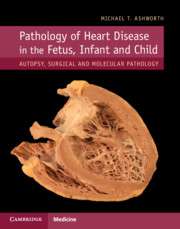Book contents
- Pathology of Heart Disease in the Fetus, Infant and Child
- Pathology of Heart Disease in the Fetus, Infant and Child
- Copyright page
- Dedication
- Contents
- Preface
- Chapter 1 The Anatomy of the Normal Heart
- Chapter 2 Examination of the Heart
- Chapter 3 Development of the Heart
- Chapter 4 Congenital Heart Disease (I)
- Chapter 5 Congenital Heart Disease (II)
- Chapter 6 Ischaemia and Infarction
- Chapter 7 Cardiomyopathy
- Chapter 8 Inflammation of the Myocardium, Endocardium and Aorta
- Chapter 9 The Coronary Arteries
- Chapter 10 Metabolic and Storage Disease
- Chapter 11 Pericardium
- Chapter 12 Fetal Cardiovascular Disease
- Chapter 13 Tumours
- Chapter 14 Heart Transplantation
- Chapter 15 Sudden Cardiac Death in the Young
- Index
- References
Chapter 6 - Ischaemia and Infarction
Published online by Cambridge University Press: 19 August 2019
- Pathology of Heart Disease in the Fetus, Infant and Child
- Pathology of Heart Disease in the Fetus, Infant and Child
- Copyright page
- Dedication
- Contents
- Preface
- Chapter 1 The Anatomy of the Normal Heart
- Chapter 2 Examination of the Heart
- Chapter 3 Development of the Heart
- Chapter 4 Congenital Heart Disease (I)
- Chapter 5 Congenital Heart Disease (II)
- Chapter 6 Ischaemia and Infarction
- Chapter 7 Cardiomyopathy
- Chapter 8 Inflammation of the Myocardium, Endocardium and Aorta
- Chapter 9 The Coronary Arteries
- Chapter 10 Metabolic and Storage Disease
- Chapter 11 Pericardium
- Chapter 12 Fetal Cardiovascular Disease
- Chapter 13 Tumours
- Chapter 14 Heart Transplantation
- Chapter 15 Sudden Cardiac Death in the Young
- Index
- References
Summary
This chapter is devoted to the macroscopic and microscopic appearance of myocardial ischaemia and includes discussion of regional myocardial infarction and of papillary muscle rupture. Coronary atherosclerosis can occur, albeit rarely, in the child, and this is discussed particularly in relation to hypercholesterolaemia. Antiphospholipid syndrome and haemolytic-uraemic syndrome are also discussed.
Keywords
- Type
- Chapter
- Information
- Pathology of Heart Disease in the Fetus, Infant and ChildAutopsy, Surgical and Molecular Pathology, pp. 155 - 163Publisher: Cambridge University PressPrint publication year: 2019



